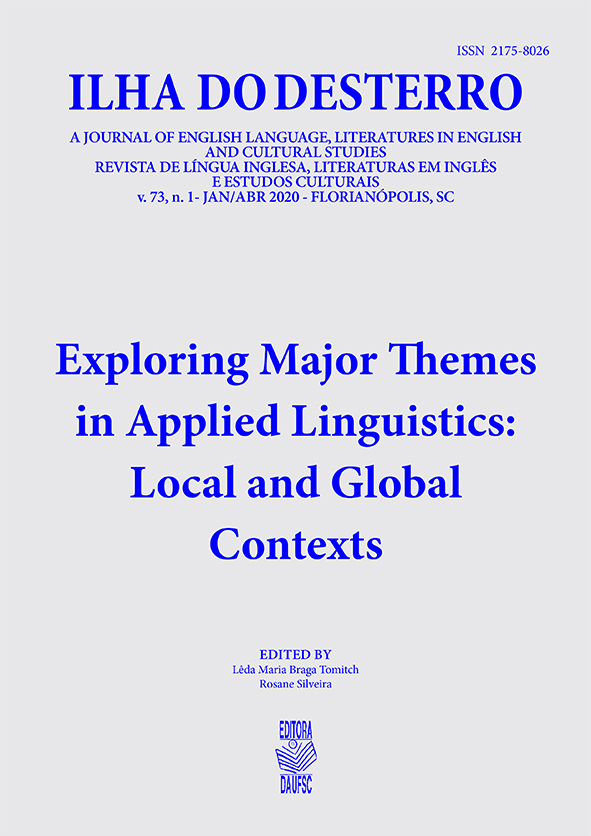O desenvolvimento da habilidade oral através do uso de tecnologias digitais: uma revisão sistemática
DOI:
https://doi.org/10.5007/2175-8026.2020v73n1p153Resumo
O presente artigo consiste em uma revisão sistemática da literatura, descritiva-interpretativa, cujo objetivos são (1) apresentar quais abordagens de ensino-aprendizagem são mais utilizadas no desenvolvimento da habilidade oral através de tecnologias digitais; (2) investigar quais ferramentas são mais utilizadas para o desenvolvimento da habilidade oral em ambiente digital; (3) quais aspectos da oralidade estão sendo mais estudados e (4) que possibilidades e restrições são indicadas. Foram analisados 56 trabalhos, entre artigos, dissertações e teses coletados de três bases de dados. As implicações deste trabalho se dão também ao apontar as lacunas de pesquisa na área, tais como a ausência de estudos sobre perspectivas críticas no trabalho com tecnologia e oralidade e a não existência de pesquisas que tratem de como se trabalha a questão da oralidade via TIC na formação inicial e continuada de professores de LE.
Referências
ANÇÃ, Maria Helena. Da Língua Materna à Língua Segunda. Noesis, nº 51, 1999, p. 14-16.
AUSTIN, J. L. Quando dizer é fazer. Porto Alegre: Artes Médicas, 1990. 211p.
BERDUGO, M. (2001). Integración de tecnologias multimedia em la enseñanza de lenguas. In: Revista Lenguaje nº 28. Pp. 84-107.
CASTRO, A. A. Revisão sistemática e meta-análise. 2001. Disponível em: http://metodologia.org/wp-content/uploads/2010/08/meta1.PDF; acesso em 14 dez. 2018.
CELANI, M. A. A. Ensino de línguas estrangeiras: ocupação ou profissão?. In: LEFFA, V. J. et al. O Professor de Línguas Estrangeiras: construindo a profissão.. 2. ed. Pelotas: EDUCAT, 2008, p. 23-43.
CHAPELLE, C. English Language Learning and Technology. Amsterdam/Philadelphia: John Benjamins Publishing Company, 2003.
CRYSTAL, D. Language and the Internet. 1 ed. Cambridge: Cambridge University Press, 2001.
DE-LA-TORRE-UGARTE-GUANILO, M. C.; TAKAHASHI, R. F.; BERTOLOZZI, M. R. Revisão sistemática: noções gerais. Revista da Escola de Enfermagem USP, São Paulo, v. 45, n. 5, p. 1260 - 1266, out. 2011.
HYMES, D. H. On Communicative Competence. In: PRIDE, J. B.; HOLMES, J. Sociolinguistics. Baltimore, USA: Penguin Education, Penguin Books Ltd, 1972, p.269-293.
KERN, R; WARSCHAUER, M. Introduction: theory and practice of network-based language teaching. Cambridge: Cambridge University Press, 2000.
KRAMSCH, C. Cultura no ensino de língua estrangeira. Tradução de Orison Marden Bandeira de Melo Júnior. Bakhtiniana, São Paulo, 2017.
KRASHEN, S. The Input Hypothesis: issues and implications. 4.ed. New York: Longman, 1985.
KUMARAVADIVELU, B. Toward a postmethod pedagogy.TESOL Quarterly, 35, 2001, 537–560.
LEFFA, V. J. Ensino de línguas: passado, presente e futuro. Revista de Estudos da Linguagem. Vol. 20, n. 2, p. 389-411, jul/dez. 2012.
LEVELT, W. J. M. Speaking: From intention to articulation. Cambridge, MA: MIT Press, 1989.
LEVELT, W. A Blueprint of the speaker. In: BROWN, C.; HAGOORT, P. The neurocognition of language. Oxford: Oxford Press, 1999.
LEVY, M. Computer-Assisted Language Learning: Context and conceptualization. Oxford: Clarendon Press, 1997.
LEVY, M; HUBBARD, P. Why call CALL “CALL”?. Computer Assisted Language Learning, vol. 18, n. 3, p. 143 – 149, jul. 2005.
MARCUSCHI, L. A. Gêneros textuais emergentes no contexto da tecnologia digital. IN:MARCUSCHI, L. A.; XAVIER, A. C. (Orgs.) Hipertexto e gêneros digitais. São Paulo: Cortez, 2010, p. 15-80.
MARTINS, C.M.M.J.; MOREIRA, H. O campo CALL (Computer Assisted Language Learning): definições, escopo e abrangência. Calidoscópio, vol. 10, n. 3, p. 247-255, set/dez 2012.
MOROSOV, I.; MARTINEZ, J. Z. Metodologia do ensino de língua portuguesa e estrangeira. Curitiba: IBPEX, 2008.
MUÑOZ, C.; ARAÚJO, L.; CEIA, C. Aprender uma segunda língua. 1ª ed. Lisboa: Fundação Francisco Manuel dos Santos, 2011.
PREUSS, E. O. Habilidade oral em L2: da cognição à interação. Horizontes de Linguística Aplicada, Brasília, n. 2, p. 167-186, jan. 2014.
RICHARDS, J. C. & RODGERS. Approaches and Methods in Language Teaching. Cambridge: Cambridge University Press, 1986.
RODRIGUES, R. H.; CERUTTI-RIZZATTI, M. E. Linguística Aplicada: ensino de língua materna. Florianópolis: LLV/CCE/UFSC, 2011.
RODRIGUES, R. R.; ORTIZ-PREUSS, E. Habilidade oral em L2: percepções de docentes e discentes. Odisseia, Natal, v. 2, n. 1, p. 72-92, jan. 2017.
SIEMENS, G. Connectivism: A Learning Theory for the Digital Age. 2004. Disponível em <http://www.elearnspace.org/Articles/connectivism.htm>. Acesso em 20 maio 2019.
SWAIN, M. Communicative competence: Some roles of comprehensible input and comprehensible output in its development. In S. Gass & C. Madden (Eds.), Input in second language acquisition (pp. 235–253). Rowley, MA: Newbury House, 1985.
WALKER, A.; WHITE, G. Technology Enhanced Language Learning. 1 ed. Oxford: Oxford University Press, 2013.
Downloads
Publicado
Edição
Seção
Licença
Copyright (c) 2020 Marjorie Menezes Soares, Sâmia Alves Carvalho

Este trabalho está licenciado sob uma licença Creative Commons Attribution 4.0 International License.
A revista Ilha do Desterro publica artigos e resenhas inéditos, referentes as áreas de Inglês, Literaturas em Língua Inglesa e Estudos Culturais. Publica volumes mistos e/ou temáticos, com artigos e resenhas em inglês e português.
Autores mantém os direitos autorais e concedem à revista o direito de primeira publicação, com o trabalho simultaneamente licenciado sob a Licença Creative Commons Attribution que permite o compartilhamento do trabalho com reconhecimento da autoria e publicação inicial nesta revista.

This work is licensed under a Creative Commons Attribution 4.0 International License.



